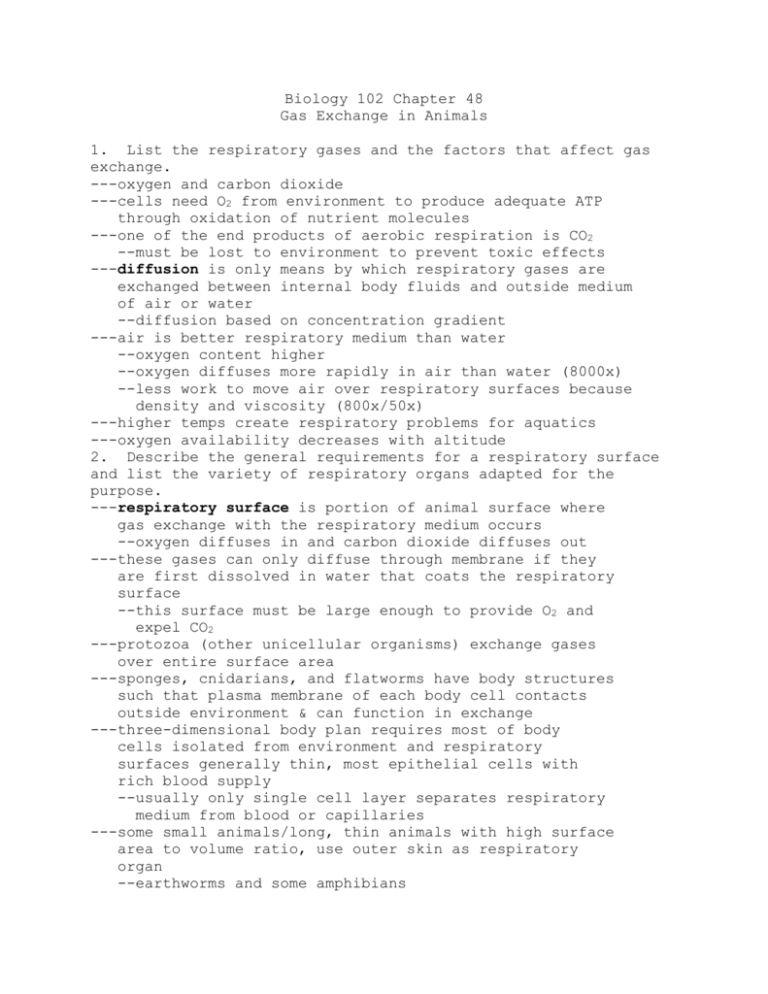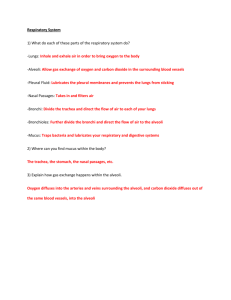Biology 102 Chapter 48
advertisement

Biology 102 Chapter 48 Gas Exchange in Animals 1. List the respiratory gases and the factors that affect gas exchange. ---oxygen and carbon dioxide ---cells need O2 from environment to produce adequate ATP through oxidation of nutrient molecules ---one of the end products of aerobic respiration is CO2 --must be lost to environment to prevent toxic effects ---diffusion is only means by which respiratory gases are exchanged between internal body fluids and outside medium of air or water --diffusion based on concentration gradient ---air is better respiratory medium than water --oxygen content higher --oxygen diffuses more rapidly in air than water (8000x) --less work to move air over respiratory surfaces because density and viscosity (800x/50x) ---higher temps create respiratory problems for aquatics ---oxygen availability decreases with altitude 2. Describe the general requirements for a respiratory surface and list the variety of respiratory organs adapted for the purpose. ---respiratory surface is portion of animal surface where gas exchange with the respiratory medium occurs --oxygen diffuses in and carbon dioxide diffuses out ---these gases can only diffuse through membrane if they are first dissolved in water that coats the respiratory surface --this surface must be large enough to provide O2 and expel CO2 ---protozoa (other unicellular organisms) exchange gases over entire surface area ---sponges, cnidarians, and flatworms have body structures such that plasma membrane of each body cell contacts outside environment & can function in exchange ---three-dimensional body plan requires most of body cells isolated from environment and respiratory surfaces generally thin, most epithelial cells with rich blood supply --usually only single cell layer separates respiratory medium from blood or capillaries ---some small animals/long, thin animals with high surface area to volume ratio, use outer skin as respiratory organ --earthworms and some amphibians -must live in water or damp places ---most other animals lack sufficient body surface area to exchange gases for entire body --possess region of body surface extensively branched or folded providing enough respiratory surface area for gas exchange ---gills are outfoldings of body surface specialized for gas exchange ---tracheal systems are air tubes that branch throughout an insect’s body ---lungs are highly vascularized invaginations of body surface that are restricted to one location 3. Describe respiratory adaptations of aquatic and terrestrial animals. ---gills are respiratory adaptations of most aquatic animals ---some invertebrates (echinoderms) have gills of simple shapes and distributed over entire body ---other invertebrates (annelids) gills are flap-like and extend over each body segment/clustered at one end and long and feathery ---others (mollusks/fish) have gills localized on a body region where surface is finely subdivided to provide large amount of surface area --gills must be efficient because water has lower oxygen [] than does air ---lungs are internal cavities for respiratory gas exchange with air --have large surface area because they are highly divided --are elastic so can be inflated and deflated with air ---insects have highly branched network of air-filled tubes called tracheae 4. Describe countercurrent exchange, and explain why it is more efficient that concurrent flow of water and blood. ---countercurrent exchange: blood flows opposite direction in which water passes over gills --maintains constant [] gradient for oxygen between blood and water passing over gill surface --remove more than 80% of O2 dissolved in water ---concurrent flow (with blood and water moving in same direction) would result in drop to 50% or < removal -occurs because of [] gradient 5. For the human respiratory system, describe the movement of air through air passageways to the alveolus, listing the structures it must pass through on the journey. ---lungs located in thoracic cavity, enclosed in sac of two layers that are held together by surface tension of fluid between them ---air entering nostrils is filtered by hairs, warmed, and moistened ---air travels through pharynx, through glottis, & into larynx (possesses vocal cords/functions as voice box) ---air enters cartilage-lined trachea that forks into two bronchi which further branch into finer bronchioles that dead-end in alveoli --alveoli lined with thin layer of epithelium which serves as respiratory surface ---O2 dissolves in moist film covering epithelium & diffuses across to capillaries covering each alveolus --CO2 moves in opposite direction by diffusion 6. Define negative pressure breathing, and explain how respiratory movements in humans ventilate the lungs. ---negative pressure breathing works like a suction pump pulling air, instead of pushing it, into the lungs ---during inhalation, contraction of rib cage causes it to expand while diaphragm contracts and descends --lungs expand and pressure inside them is lowered --air pressure now lower than in atmosphere --air rushes into nostrils and down breathing tubes ---during exhalation, rib muscles and diaphragm relax --lung volume is decreased and pressure inside them > --air forced out of lungs 7. Define the following lung volumes, and give a normal range of capacities for the human male: a. tidal volume b. vital capacity c. residual volume. ---tidal volume is volume of air inhaled and exhaled with each breath during normal quiet breathing; 500 mL ---vital capacity is maximum air volume that can be inhaled and exhaled during forced breathing; 4800 mL ---residual volume is amount of air remaining in lungs even after forced exhalation; 1200 mL 8. List the barriers oxygen must cross from the alveolus into the capillaries, and explain the advantage of having millions of alveoli in the lungs. ---oxygen must cross the squamous epithelium cell lining of alveolus; cross the endothelial lining of an adjacent capillary, and cross the fused basement membrane that lie between the alveolar and endothelial cells ---all gas exchange occurs by simple diffusion --pressure gradient needed to insure diffusion ---each alveolus is very small but combined surface area of the 300 million (or so) alveoli is about 70 m2 (size of badminton court 9. Describe how oxygen moves from the alveolus into the capillary, and explain why a pressure gradient is necessary. ---blood arriving at lungs via pulmonary arteries has lower PO2 and higher PCO2 than air in the alveoli ---blood exchanges gases with air in alveoli and the PO2 of the blood increases while the PCO2 decreases ---in tissue capillaries, gradients of partial pressure favor diffusion of oxygen out of blood and diffusion of CO2 into it, since cellular respiration rapidly depletes interstitial fluid of O2 and adds CO2 ---simple diffusion based on movement of molecules from where they are more highly []ed to where they are less []ed 10. Describe the structure of hemoglobin, explain the result of cooperative binding, and state how many oxygen molecules a saturated hemoglobin molecule can carry. ---four subunits with heme group that binds O2 ---iron atom at center of each heme group is binder ---binding of oxygen to hemoglobin is reversible ---binding of O2 to 1 subunit induces shape change that increases affinity of other 3 subunits for oxygen --known as cooperativity ---unloading of oxygen from 1 heme group results in conformational change that stimulates unloading from other 3 subunits ---hemoglobin can carry 4 molecules of O2 11. Draw the Hb-oxgyen dissociation curve, explain the significance of its shape, and explain how the affinity of hemoglobin for oxygen changes with oxygen concentration. ---where curve has steep slope, even slight change in POs causes hemoglobin to load or unload substantial amount of oxygen ---slight drop in POs is enough to cause relatively large increase in amount of oxygen the blood unloads 12. Describe the Bohr effect, and explain how the oxygen dissociation curve shifts with changes in carbon dioxide concentration and changes in pH. ---pH decreases (becomes more acidic) in very active tissues because CO2 produced by respiration reacts with water to form carbonic acid ---Bohr shift is lowering of hemoglobins’ affinity for O2 upon drop in pH --occurs in active tissues due to entrance of CO2 into the blood ---as pH decreases in tissues, hemoglobin gives up more its oxygen 13. Describe how carbon dioxide is picked up at the tissues and deposited in the lungs, describe the role of carbonic anhydrase, and state the form most of the carbon dioxide is in as it is transported. ---carbon dioxide produced by body tissues diffuses into interstitial fluid and into plasma within a capillary ---less than 10% remains in plasma as dissolved CO2 ---over 90% diffuses into red blood cells ---some is picked up and transported by hemoglobin ---most of CO2 reacts with H2O in erythrocyte to form carbonic acid (H2CO3) ---red blood cells contain carbonic anhydrase which catalyzes this reaction ---carbonic acid dissociates into a bicarbonate ion (HCO3-) and a hydrogen ion (H+) ---hemoglobin binds most of H+s from carbonic acid --prevents them from acidifying the blood ---most of bicarbonate ions diffuse into plasma --carried by blood stream to lungs ---reverse scenario occurs in the lungs 14. Explain how hemoglobin acts as a buffer. ---reversibility of carbonic acid-bicarbonate conversion helps buffer the blood, releasing or removing H+ depending on pH





